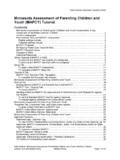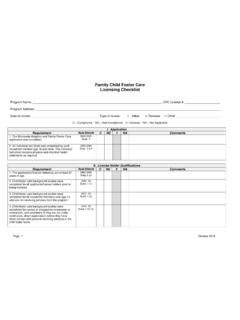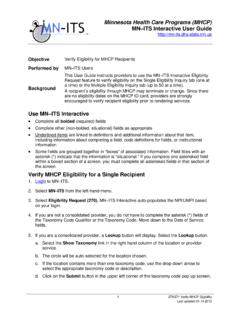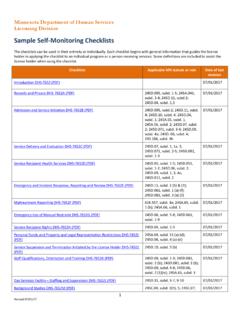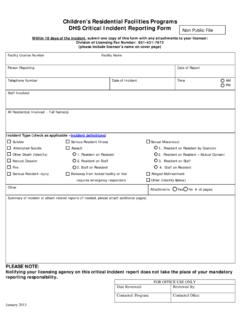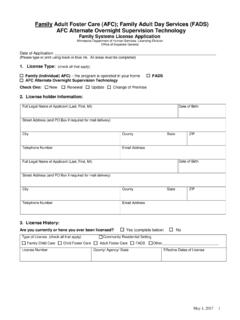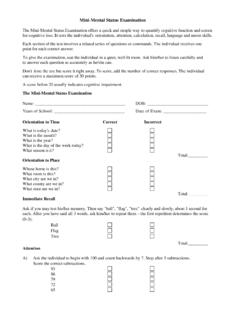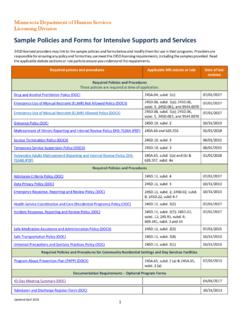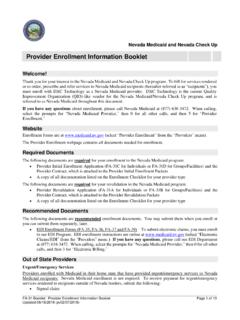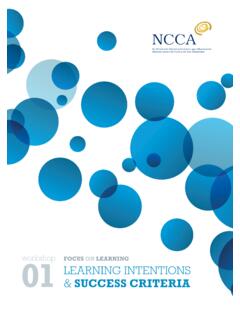Transcription of LOCUS QUESTIONNAIRE Booklet
1 Revised 8/30/10 1 LOCUS QUESTIONNAIRE Booklet Please do not write on. Enter ratings on LOCUS Recording Form Level of Care Utilization System for Psychiatric and Addiction Services 2010 Instructions for Use Each dimension has a scale of one to five. Each score in the scale is defined by one or more criteria. Only one of these criteria need be met for a score to be assigned to the subject. The evaluator should select the highest score or rating in which at least one of the criteria is met. Sometimes it s not clear which score is the best fit. This may be due to lack of information, conflicting information, or how well a particular case fits the exact criteria for that score. Then we must use clinical judgment and pick the closest fit.
2 The highest score in which it is more likely than not that at least one criterion has been met should generally be assigned. The result will be that any errors will be made on the side of caution. Since LOCUS is designed as a dynamic instrument, scores should be expected to change over time. Scores are generally assigned on a here and now basis, representing the clinical picture at the time of evaluation. In some of the parameters, historical information is taken into account, but it should not be considered unless it is a clear part of the defined criteria. In certain crisis situation, the score may change rapidly as interventions are implemented. In other situation, where a subject may be living under very stable circumstances, scores may not change for extended periods of time. Clinical judgment should prevail in the determination of how frequently scores should be reassessed.
3 As a general rule, they will be reassessed more frequently at high levels of acuity and at the higher levels of care or resource intensity. Once scores have been assigned in all six-evaluation parameters (7 counting the subsections of Recovery Environment ), they should be recorded on a worksheet and added to obtain the total score. Referring to the LOCUS placement grid, a rough estimate of the placement recommendation can be obtained. For the greatest accuracy, the LOCUS Level of Care decision tree should be employed and it is recommended that it be used in most cases. When services at all levels of care are not available, placing a person at the closest available higher level is the safest choice. Revised 8/30/10 2 LOCUS Instrument Version 2010 Evaluation Parameters for Assessment of Service Needs Definitions I.
4 Risk of Harm This dimension of the assessment considers a person s potential to cause significant harm to self or others. While this may most frequently be due to suicidal or homicidal thoughts or intentions, in many cases unintentional harm may result from misinterpretations of reality, from inability to adequately care for oneself, or from altered states of consciousness due to use of intoxicating substances in an uncontrolled manner. For the purposes of evaluation in this parameter, deficits in ability to care for oneself are considered only in the context of their potential to cause harm. Likewise, only behaviors associated with substance use are used to rate risk of harm, not the substance use itself. In addition to direct evidence of potentially dangerous behavior from interview and observation, other factors may be considered in determining the likelihood of such behavior such as: past history of dangerous behaviors, inability to contract for safety (while contracting for safety does not guarantee it, the inability to do so increases concern), and availability of means.
5 When considering historical information, recent patterns of behavior should take precedence over patterns reported from the remote past. Risk of harm may be rated according to the following criteria: 1- Minimal Risk of Harm a. No indication of suicidal or homicidal thoughts or impulses, and no history of suicidal or homicidal ideation, and no indication of significant distress. b. Clear ability to care for self now and in the past. 2- Low Risk of Harm a. No current suicidal or homicidal ideations, plan, intentions or severe distress, but may have had transient or passive thoughts recently or in the past. b. Substance use without significant episodes of potentially harmful behaviors. c. Periods in the past of self-neglect without current evidence of such behavior. 3- Moderate Risk of Harm a. Significant current suicidal or homicidal ideation without intent or conscious plan and without past history. b. No active suicidal/homicidal ideation, but extreme distress and /or a history of suicidal/homicidal behavior exists.
6 C. History of chronic impulsive suicidal/homicidal behavior or threats and current expressions does not represent significant change from baseline. d. Binge or excessive use of substances resulting in potentially harmful behaviors without current involvement in such behavior. e. Some evidence of self-neglect and/or compromise in ability to care for oneself in current environment. 4- Serious Risk of Harm a. Current suicidal or homicidal ideation with expressed intentions and/or past history of carrying out such behavior but without means for carrying out the behavior, or with some expressed inability or aversion to doing so, or with ability to contract for safety. b. History of chronic impulsive suicidal/homicidal behavior or threats with current expressions or behavior representing a significant elevation from baseline. c. Recent pattern of excessive substance use resulting in disinhibition and clearly harmful behaviors with no demonstrated ability to abstain from use.
7 D. Clear compromise of ability to care adequately for oneself or to be adequately aware of environment. 5- Extreme Risk of Harm a. Current suicidal or homicidal behavior or such intentions with a plan and available means to carry out this expressed ambivalence or significant barriers to doing so, OR a2. with a history of serious past attempts which are not of a chronic, impulsive or consistent nature, OR a3. in presence of command hallucinations or delusion which threaten to override usual impulse control. b. Repeated episodes of violence toward self or others, or other behaviors resulting in harm while under the influence of intoxicating substances with pattern of nearly continuous and uncontrolled use. c. Extreme compromise of ability to care for oneself or to adequately monitor environment with evidence of deterioration in physical condition or injury related to these deficits. Revised 8/30/10 3 II.
8 Functional Status This dimension of the assessment measures the degree to which a person is able to fulfill social responsibilities, to interact with others, maintain their physical functioning(such as sleep, appetite, energy, etc.), as well as a person s capacity for self care. This ability should be compared against an ideal level of functioning given an individual s limitations, or may be compared to a baseline functional level as determined for an adequate period of time prior to onset of this episode of illness. Persons with ongoing, longstanding deficits who do not experience any acute changes in their status are the only exception to this rule and are given a rating of three. IF such deficits are severe enough that they place a client at risk of harm, they will be considered when rating Dimension I in accord with the criteria elaborated there. For the purpose of this document, sources of impairment should be limited to those directly related to the psychiatric and/or addiction problems that the individual may be experiencing.
9 While other types of disabilities may play a role in determining what types of support services may be required, they should generally not be considered in determining the placement of a given individual in the behavioral treatment continuum. 1-Minimal Impairment a. No more than transient impairment in functioning following exposure to an identifiable stressor. 2-Mild Impairment a. Experiencing some deterioration in interpersonal interactions, with increased irritability, hostility or conflict, but is able to maintain some meaningful and satisfying relationships. b. Recent experience of some minor disruptions in aspects of self care or usual activities. c. Developing minor but consistent difficulties in social role functioning and meeting obligations such as difficulty fulfilling parental responsibilities or performing at expected level in work or school, but maintaining ability to continue in those roles. d. Demonstrating significant improvement in function following a period of deterioration.
10 3-Moderate Impairment a. Recently conflicted, withdrawn, alienated or otherwise troubled in most significant relationships, but maintains control of any impulsive or abusive behaviors. b. Appearance and hygiene falls below usual standards on a frequent basis. c. Significant disturbances in physical functioning such as sleep, eating habits, activity level, or sexual appetite, which do not pose a serious threat to health. d. Significant deterioration in ability to fulfill responsibilities and obligations to job, school, self, or significant others and these may be avoided or neglected on some occasions. e. Ongoing and/or variably severe deficits in interpersonal relationships, ability to engage socially constructive activities, and ability to maintain responsibilities. f. Recent gains and/or stabilization in function have been achieved while participating in treatment in a structured and/or protected setting. 4-Serious Impairment a.
